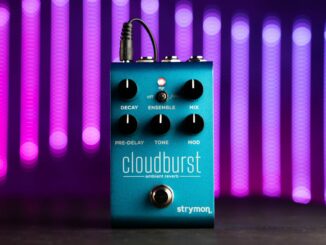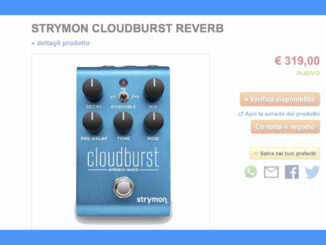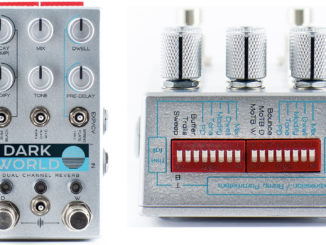Walrus Audio has turned its best-selling SLÖ ambient reverb pedal into a stereo processor with more algorithms and stretch called Slöer.
In the past few months, I’ve been working more intensively with guitar pedals and effects in general. An exciting journey that you can follow on YouTube. The first pedal videos with synths already exist. One is the Walrus Audio Slö, a lovely-sounding ambient reverb that fits perfectly with synths. Full review here.
One of my criticisms is that the SLÖ is only a mono-to-mono reverb pedal, which is suboptimal for synths. Many modern synths have stereo I/O on the back. I guess I wasn’t the only one with this criticism. Walrus Audio has now reacted and unveiled the Slöer, the stereo version of the SLÖ ambient reverb. But with more inspiring features.
Walrus Audio Slöer
The new Slöer is a new ambient reverb that builds on the popular Slö and Slötva pedals. The developers took the popular algorithms and features and raised them to the stereo level. But they didn’t leave it to that.
Besides the classic algorithms dark, rise, and dream, Slöer features two new reverb algorithms: rain and light. More precisely:
- dark: a deep and wide atmospheric reverb with a lower octave in the reverb trail.
- rise: an auto-swell reverb for beautiful cinematic swells
- dream: a lush, dreamy reverb with a latching pad function
- rain (new) aka delay tap diffusion: tappy and trippy, this program creates a unique effect with lower levels of diffusion, allowing the reverb delay taps to create an echo-like effect within your reverb audibly
- light (new): bright and smooth reverb with an octave-up shimmer for ethereal sounds.
Then, they added stereo width control with three options (wide, medium, and narrow) and two additional wave shapes, giving you more modulation options. Like the original pedals, it hosts the same parameters, including control over the decay, filter, and mix.
Sample Rate Control
Another significant addition is the ability to modify the sample rate. It’s called stretch. This way, you can crunch down your reverbs, giving them more character. Further, you get the best-known momentary functions, and an option to run the pedal in trails or no trails mode.
And you can also save your presets in the Slöer pedal. There is a neat preset spillover function that allows you to scroll through presets with the same algorithms without cutting your reverb trails. This only works if the presets have the same algorithm.
No Synth Demo?
Walrus Audio introduces the SLÖ algorithms to the stereo world for the first time with this new pedal. So it will also be more exciting to use with synthesizers. But this doesn’t seem to be a topic with the demos once again. Strange.
Here is my demo of the SLÄRP with synths which includes the SLÖ reverb pedal.
First Impression
I am very happy that the Slö now has a stereo brother called Slöer with more features on top. The original algorithms sound excellent, even with synths. Now all in stereo and with new algorithms and features. Yes, I’m very curious about how the whole thing sounds with electronic sounds.
Walrus Audio Slöer is available now for $349,99 in a blue or black finish.
More information here: Walrus Audio
Available at my partners





I’m wondering how the stereo is implemented: True stereo (L and R are independent, both dry and wet) or stereo i/o with a stereo reverb based on a summed-to-mono dry signal (like most of the Strymon pedals). True stereo is better obviously, as it maintains the original stereo image (for example, if using a stereo chorus).
No, “true stereo” is not better.You’ll not find it on reverbs. Summed mono blended with stereo dry is how it’s almost always done.
Sorry, that’s just not true. Lots of VST effects have true stereo. A true stereo reverb simulates the acoustic reverberations of a stereo sound source (e.g., two separate speakers in a room). There can be some blending of L and R, but fully combining them into a mono input signal is not more accurate or better in any way.
For example, if I run a synth through a stereo chorus that adds different modulations to L and R, and then into a reverb, I would like to hear more L in the L side of the reverb, and more R in the R side – both dry and wet. Also, when using stereo choruses and phasers, summing L and R can result in muddy sound.
yeah that’s not true- there are plenty of true stereo effects in pedal, rack, etc.. form. there’s a whole reddit page dedicated to listing true stereo effects including chorus and reverb. true stereo is more ideal than summed mono for many purposes.
Think about how actual reverb in a room works…
Let’s say someone to your left is singing. You hear the direct, unreflected “dry” signal in your left ear, then in your right with a very slight phase offset, and the acoustic shadow of your head.
And then in both ears, you hear reflections off the floor, the walls to your left, right, front and rear, and the ceiling, and any other objects in the room that don’t completely absorb the sound.
“True stereo” reverb that fully separates channels would sound wrong, but combining to mono is pretty close to what really happens.
For a fully realistic room simulation, of course you’d have to know where you are located not just relative to the source audio, but where both you and the source are relative to the walls…
starthief you are correct in speaking about traditional room recording, but when it comes to synths and electronic music etc., you’re creating in an isolated, simulated space. therefore you can do things you wouldn’t normally be capable of in real life recording situations. summed mono can be just fine enough for certain tracks/ sounds but other times you want to retain stereo effects and panning while going thru reverb. summed mono would collapse many creative characteristics like chorus, ping/pong, and more. some popular pedals are amazing but mono sum and therefore I don’t use ’em!